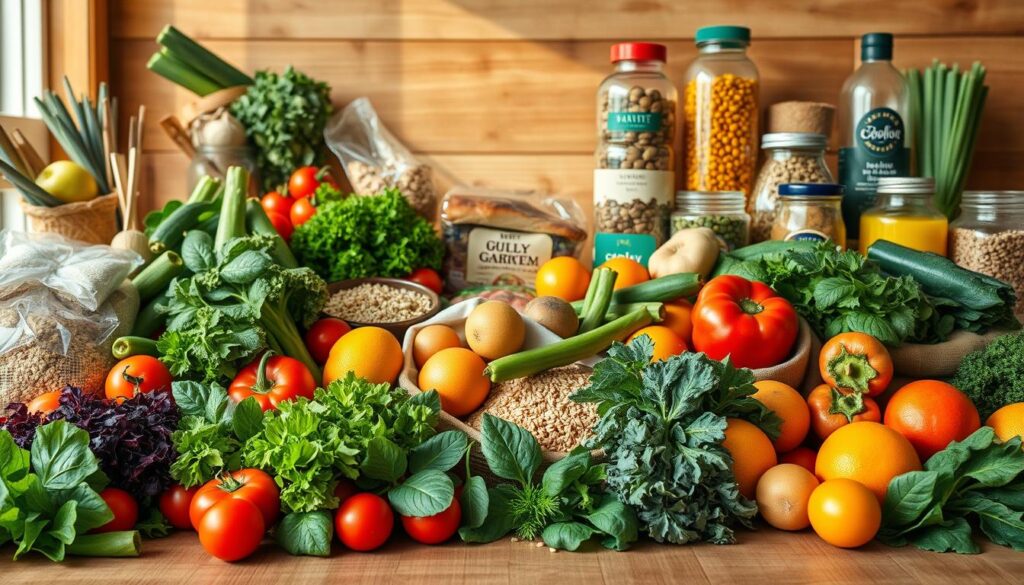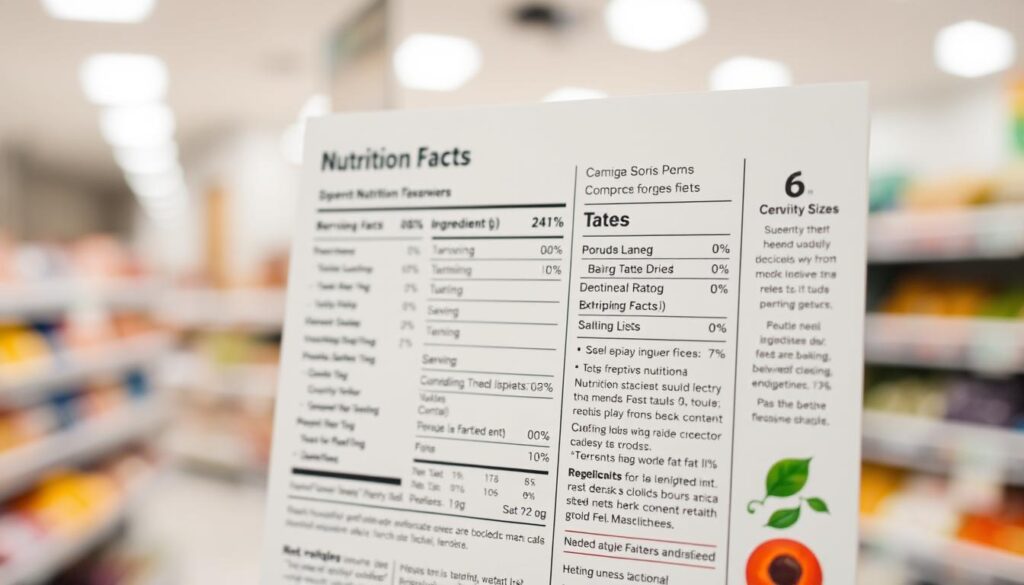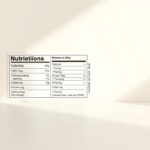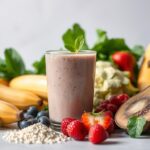Table of Contents
Smart Grocery Shopping is essential for choosing the right foods that boost your energy and overall health. With so many products making different claims, knowing what’s truly good for you can be confusing. Making smart food choices and selecting nutritious items will help you shop wisely and stay healthy. To complement your healthy shopping habits, check out our 10 Healthy Eating Tips for Weight Loss and Muscle Gain for practical nutrition advice.

Every week, you routinely spend both time and money on buying groceries. Consider, however, the possibility that these choices could one day directly affect your health. This guide will help you read labels, select more nutrient-rich foods, and make healthy habits. Let’s take on the big ones: too many choices, understanding nutrition labels, and a tiny decision affecting so much.
Key Takeaways
- Meal planning reduces impulse buying of unhealthy food.
- Reading ingredient lists indicates sugars and additives that one may otherwise not be aware of.
- Prioritizing whole foods helps obtain an energy boost and an extra nutrient intake.
- Intelligent tricks save time and money while enhancing diet quality.
- Digital tools make tracking and comparing food choices easy.
Why Healthy Grocery Shopping Matters for Your Wellbeing
Going to the store is an opportunity to reinforce healthy dietary habits. Every choice made today is a decision for daily eating for you and your family for days to come. Studies show that 72% of Americans shop healthy if they have planned some meals, which is good for diet quality. So, let’s take a look at why this habit is so important for long-term health maintenance.
The Connection Between Shopping Habits and Diet Quality
Balanced meals are held in your cart. According to a USDA study, houses that buy more fruits, vegetables, and lean proteins consume 30% more nutrients daily than those that buy less. Buy the best foods for good health, such as whole grains and plant-based proteins. Here’s how:
- Plan meals weekly to avoid spontaneous purchases
- Choose unprocessed products instead of processed convenience foods
- Look for hidden sugars and sodium on nutrition labels
How Your Grocery Choices Impact Family Health
“Children’s eating habits mirror what parents bring home,” says the American Heart Association. Families who shop together learn to prefer nutritious options.
According to the experts, establish lifelong preferences by keeping fresh fruits and vegetables in the home and limiting sweet treats. Children who eat vegetables are 50 percent more likely to eat the same as adults. Your choices define what’s normal—and healthy—for your family.
The Long-term Benefits of Nutritious Food Selections
| Benefit | Impact |
|---|---|
| Chronic Disease Prevention | Lower risk of heart disease, diabetes |
| Energy Levels | Steady fuel from whole foods |
| Weight Management | Portion control through mindful purchases |
| Mood & Cognition | Omega-3s and antioxidants boost brain function |
Small modifications at present tend to develop into ripple effects. An investment in nutrient-rich foods today will pay dividends in energy, vitality, and disease resistance tomorrow.
Preparing for Success: Pre-Shopping Strategies
Preparation is essential for a grocery list to prepare healthy eating success. Check your pantry first to avoid buying stuff you may have at home. Things that have expired can be considered for your next grocery list.
“A cluttered pantry leads to wasted money and poor choices.”
Develop a menu using three-day nutrition planning: Select three breakfasts, three lunches, and three dinners. Meal pairings allow an ingredient to be reused; for example, grilled chicken could be used in salads and tacos. That way, waste is lowered.
- Pantry Audit: Remove expired items and list what you need.
- Meal Map: Plan 3 days of meals, then double the ingredients for weekly prep.
- Create Your List: To stay on track, organize items by store section (produce, dairy, etc.).
| Section | Items | Purpose |
|---|---|---|
| Produce | Leafy greens, berries, carrots | Rich in vitamins and fiber |
| Proteins | Chicken breast, lentils, Greek yogurt | Lean protein sources |
| Pantry | Oats, quinoa, canned beans | Base for quick meals |
Be on the safe side and set realistic budgets. Use in-season fruits and vegetables; they are fresher and more affordable. For example, apples are cheaper during the fall, not in winter. Visit the grocery store when it is not so busy, such as mid-morning, and try to avoid visitations during busy hours.
Navigating the Grocery Store Like a Nutrition Expert

Stores try their best to influence your choices, but you can use those layouts to your advantage. With this guide to shopping for groceries, walk your way through the maze and keep your eyes on nutrition:
Understanding Store Layouts to Find the Healthiest Options
High-margin items are often placed at eye level or near entrances. Look for these key areas instead:
- Fresh produce: Begin here for colorful fruits and veggies—nature’s best.
- Butcher/deli counters: Find lean meats and fresh seafood towards the back.
- Dairy aisle: Choose low-fat or plant-based options near the fridge.
Perimeter Shopping: Why the Store Edges Matter
The outer ring is where the best food is, spend 70% of your time here:
- Produce section: Select seasonal items for the best taste and value.
- Fish counters: Seek out wild-caught salmon or sustainable seafood labeled “fresh today.”
- Unprocessed dairy: Compare Greek yogurt (high in protein) to flavored yogurts with added sugars.
Areas to Approach with Caution
Center aisles need extra attention. Use these tips when shopping:
- Read labels: Steer clear of items with added sugars, sodium, or artificial additives.
- Compare brands: Store brands often match name brands in quality but cost less.
- Check dates: Choose products with the latest “sell by” dates on the packaging.
Learning these tips turns any store into a partner in creating a healthy pantry. Every shopping trip is a chance to make better health choices.
The Ultimate Guide to Smart Grocery Shopping
A journey into eating healthily will start at the planning stage, and in this case, every step forward must mean great victories.

Creating Balanced Meal Plans That Guide Your Purchases
Initiate the weekly meal plan. Including protein, whole grains, veggies, and fruits. For example, Monday dinner could consist of grilled chicken, quinoa, and broccoli.
Make a list with this plan. Don’t waste money on things you don’t need. Plan to Eat is one of those apps that helps make easy lists using templates.
Seasonal Shopping for Maximum Nutrition and Value
Buying seasonal produce is better for your taste and your wallet. Here’s when to buy what in the U.S.:
- Winter: Citrus fruits, winter squash
- Spring: Asparagus, strawberries
- Summer: Berries, corn
- Fall: Pumpkins, apples
Check Seasonalfoodguide.org for local produce and recipes.
Digital Tools to Support Healthier Shopping Decisions
ShopWell is an app that scans barcodes to expose hidden additives. Misfits Market sells ugly fruits and vegetables at discount rates. Google Shopping will help you find the best prices for the healthiest food. These are handy applications to help you stay healthy.
Decoding Food Labels and Nutritional Information
Learning to read labels is part of understanding tips for good nutrition shopping. Smart reading will help you find good ingredients, while bad ones will be rejected. Here are guidelines for reading packaging labels and interpreting all information provided about an item.

- First, look at the serving size. Make sure you know how much you’re really eating.
- Next, check the % Daily Value. Look for foods with less than 5% saturated fat and sodium. Choose foods with 20% or more fiber and vitamins.
- Watch out for hidden sugars. Terms like “cane syrup” or “dextrose” mean added sugars.
| Label Term | Regulatory Meaning | What to Look For |
|---|---|---|
| Organic | 95%+ certified organic ingredients | USDA Organic seal |
| Whole Grain | Must contain 51% whole grains by weight | “100% whole grain” claims |
| Natural | No legal definition; avoid vague claims | Check ingredient lists instead |
The list of ingredients tells you more than labels. Choose foods with short ingredient lists first. Avoid artificial additives, “partially hydrogenated oils,” and very long chemical names.
Check for certifications for specific diets. FDA-certified foods are gluten-free. Look for low sodium for sodium watchers.
These tips on nutrition shopping give you a learning opportunity every time you shop. Spot the bad signs and look for the verified claims; every decision you make will be better.
Healthy Shopping on a Budget: Making Every Dollar Count
Shop for healthy foods and worry less about the bills. Here are some useful tips to ensure you won’t feel food shortchanged from spending a little extra cash:
Price Comparison Strategies for Nutritious Foods
- Compare unit prices: Look for price per ounce or serving on tags on store shelves.
- Seasonal produce: Apples and carrots cost less in the fall and winter, while berries and corn drop in price during summer.
- Clip digital coupons: Apps like Rakuten combine cashback rewards with printable savings.
Bulk Buying: When It Makes Sense
| Best for Bulk | Avoid Bulk |
|---|---|
| Quinoa (3lb bags) | Pre-cut veggies |
| Canned beans | Leafy greens |
| Frozen berries | Herbs (fresh) |
Store Brands vs. Name Brands
Store brands match name brands in nutritional quality 85% of the time (Consumer Reports 2023)
Try out these cost-saving alternatives:
- Walmart’s Great Value Oats vs. Quaker Oats (same fiber content, $0.50 savings per box)
- Target’s Archer Farms apples vs. branded organic apples (same USDA grading standards)
Stick with name brands only for specialty items like gluten-free products where texture consistency matters most.
Time-Saving Tips for Efficient and Healthy Shopping
Apply time management practices to shopping without compromising nutrition. Consider these grocery shopping strategies for a quick entrance and exit into the store. They are easy tips that anyone can adhere to, even with a packed schedule.
Streamlining Your Shopping Routine
- Organize your walk based on the layout of the store, starting with produce and working into the perimeter
- Weekly, advocate for fresh weekly produce, while pantry staples can be purchased once every two weeks.
- Shop early for the freshest items or late for discounts on near-expiration foods
Meal Prep-Ready Choices
Choose ingredients that can be used in many meals:
- Versatile staples like sweet potatoes or canned beans
- Put ripe fruits aside for immediate use and firmer produce for later
- Use pre-cut veggies (like Walmart’s Simply Asia line) for quick prep
Online Grocery Strategies
Platforms like Instacart or Amazon Fresh can save you time if used correctly:
- Use filters for “organic” or “low-sugar”
- Save your lists for one-click orders
- Freeze pre-washed greens after delivery to keep them fresh longer
Combine these grocery shopping tips with meal plans. This can cut down your prep time by 30% or more.
Conclusion: Transform Your Health One Shopping Trip at a Time
Each time you visit the store, there is an opportunity to make such healthy choices. Smart grocery shopping is not about perfection; it is about progress. So, start simple: choose one strategy, such as checking labels or planning meals, and add more.
Don’t worry about having the time or money. Shop by store brands, seasonal produce, and bulk to save money without cutting corners on nutrition. If other family members disagree with taste, get their involvement in picking out the new healthy foods to ease things up.
So, smart grocery shopping counts. Little by little, you’ll be replacing those many processed snacks with whole meals. These habits will stick forever. Apps like MyFitnessPal or stores like Walmart’s Great Value line can be really helpful in making it easier.
If you get stuck, return to this guide for fresh ideas. Every purchase is, after all, a step closer to health. Start today by swapping one thing out for a healthier model. These small changes will fit right into your daily routine in a short period.
FAQ
How to Make Healthy Grocery Shopping?
First, create a shopping list based on a balanced menu plan; try to eat whole foods like fruits, vegetables, lean proteins, and whole grains. Lastly, avoid shopping for groceries without eating first to avoid impulse purchasing.
Instead, shop on the perimeter where fresh items are usually located in the store.
How can I make a grocery list for healthy eating?
To start off, survey your pantry and fridge to see what you have in stock. Do not use the typical healthy grocery list format; instead, come up with a weekly meal plan that entails varied food groups. Then, look for colorful fruits and vegetables, lean protein, healthy fat, and whole grains.
Organize the list by store sections. This will reduce the time spent in the store.
What is perimeter shopping, and what are its benefits?
Perimeter shopping means concentrating around the periphery of the grocery store. You find all fruits, vegetables, meats, and dairy here. This is clear to stay away from processed foods in these inner aisles, thereby rendering those healthier options.
How can I do healthy grocery shopping in a budget-friendly way?
Go for cheap but nutritious foods like beans, freeze-dried fruits, and in-season produce. At the grocery store, learn about sales and coupons and buy in bulk where possible. Always compare unit prices to get the best bargain for any healthy food.
Is there a digital gadget that supports me to gain a healthy grocery shopping experience?
Totally! Most shopping mobile apps, such as Yummly or MyFitnessPal, help track nutrition. Apps such as Instacart can even help you shop for groceries online according to your food requirements. This makes meal planning, grocery lists, and calorie tracking easier.
What do you search for while decoding food labels?
When reading food labels, look at the servings, calories, and then the major nutrients in the fat, sugar, and sodium categories. It would be better if you chose the short ingredient labels because they are without many side foods by just waiting for whole food ingredients. So be careful about misleading terms like low-fat or natural.
How do meal preparations contribute to healthy grocery shopping?
Meal preparation is an interesting consideration as it allows you to utilize versatile ingredients in many dishes. Select food items that work well, are relatively simple to make, and can last quite a long time, which cuts waste and promotes a healthy lifestyle.




